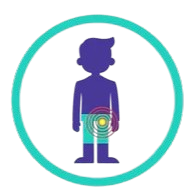

Focused shockwave therapy (fSWT) is a non-invasive treatment option for sciatica, offering pain relief, reduced inflammation, enhanced tissue healing, and faster recovery. When combined with other physiotherapy modalities such as manual therapy, exercise rehabilitation, and posture correction, it provides a comprehensive approach that addresses both the symptoms and underlying causes of sciatica. This holistic treatment strategy helps clients recover more quickly and also reduces the risk of recurrence, enabling them to regain full function and improve their quality of life.
Sciatica is a condition characterised by pain that radiates along the path of the sciatic nerve, which runs from the lower back through the hips and down the back of each leg. It typically occurs when the sciatic nerve is compressed or irritated, often due to a herniated disc, bone spur, spinal stenosis, or tight congested muscles. Sciatica can cause varying degrees of pain, numbness, tingling, or weakness in the affected leg.
A course of shockwave therapy and physiotherapy for sciatica usually involves 5 to 8 sessions, spaced about one week apart. Each session lasts 30 minutes. The exact number of sessions may vary depending on the severity of the condition and the client’s response to treatment.
The intensity and frequency of the shockwaves are carefully adjusted based on the client’s pain tolerance and the characteristics of the condition.
Clients can usually resume normal activities immediately after treatment, although they will be advised to avoid strenuous or high-impact activities for a short period if possible.
Some clients may experience mild soreness or swelling in the treated area. This typically resolves within a few days.
Focused shockwave therapy offers a non-surgical option for treating sciatica, reducing the need for invasive procedures and minimising the associated risks.
Many clients experience significant pain relief after just a few sessions, allowing them to return to normal activities with reduced discomfort.
By promoting tissue regeneration and reducing inflammation, shockwave therapy accelerates the healing process, leading to faster recovery times compared to traditional treatments.
Effective pain management through shockwave therapy can decrease the need for pain medication or anti-inflammatory medication, reducing potential side effects.
As pain decreases and tissue health improves, clients regain better movement and strength in their lower back and legs, enabling them to return to normal activities.
Clinical studies and/or client outcomes indicate that shockwave therapy is highly effective in treating sciatica, especially in cases where other traditional treatments have failed.